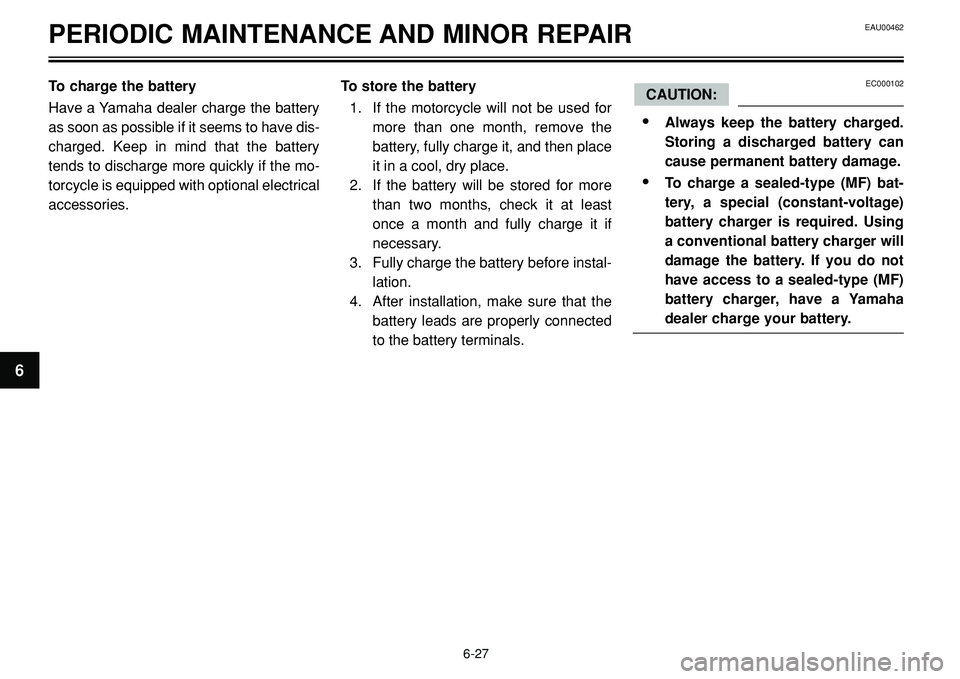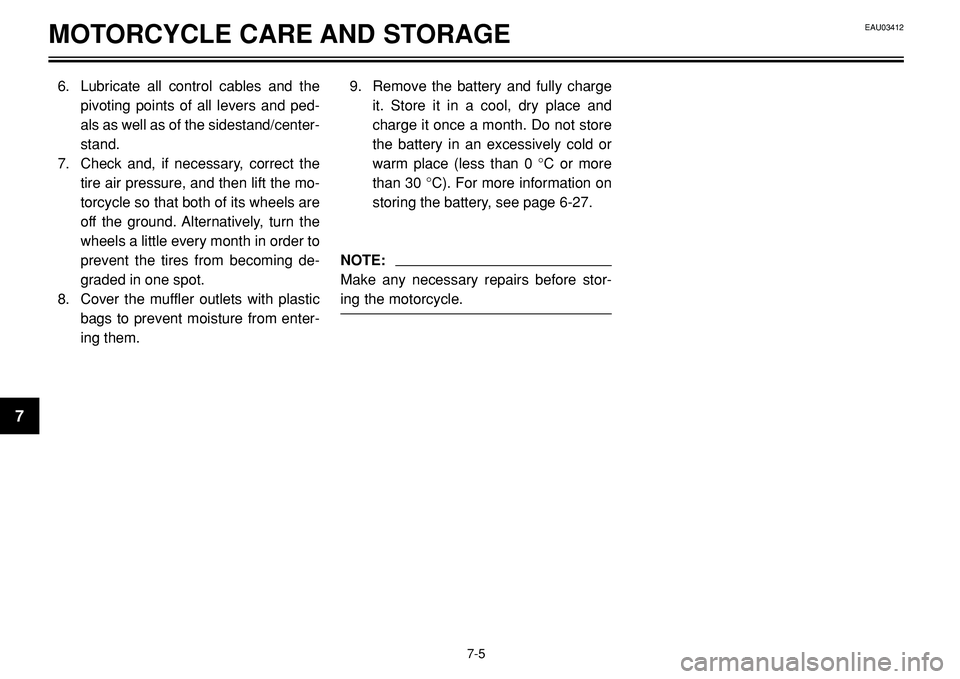2003 YAMAHA BT1100 battery
[x] Cancel search: batteryPage 11 of 96

78910
1211
DESCRIPTIONEAU00026
2-2
2
7. Fuse box (page 6-28)
8. Battery (page 6-26)
9. Helmet holders (page 3-14)
10. Air filter element (page 6-10)
11. Engine oil filter element (page 6-6)
12. Brake pedal (page 3-10)
Right view
Page 15 of 96

INSTRUMENT AND CONTROL FUNCTIONS
220 200 180 160 140 120
100
80
60
40
20
km/h345
6
7
2
1
0
N
34 512EAU01590
F(Parking)
The steering is locked, and the taillight and
auxiliary light are on, but all other electrical
systems are off. The key can be removed.
The steering must be locked before the
key can be turned to “
F”.
ECA00043
Do not use the parking position for an
extended length of time, otherwise the
battery may discharge.
CAUTION:
EAU03034
Indicator and warning lights
EAUB0001
Oil level warning light “v”
This warning light comes on when the en-
gine oil level is low.
The electrical circuit of the warning light
can be checked according to the following
procedure.
1. Turn the key to “
I” (ON). The warn-
ing light should come on for a few
seconds.
1. Oil level warning light “v”
2. Turn signal indicator light “y
y”
3. Neutral indicator light “N”
4. High beam indicator light “
1”
5. Fuel level warning light “K”
2. If the warning light does not come on,
have a Yamaha dealer check the
electrical circuit.
NOTE:
Even if the oil level is sufficient, the warn-
ing light may flicker when riding on a slope
or during sudden acceleration or decelera-
tion, but this is not a malfunction.
NOTE:
This model is equipped with a self-diagno-
sis device for the oil level warning light cir-
cuit. (See page 3-6 for an explanation of
the self-diagnosis device).
EAU00057
Turn signal indicator light “y
y”
This indicator light flashes when the turn
signal switch is pushed to the left or right.
EAU00061
Neutral indicator light “N”
This indicator light comes on when the
transmission is in the neutral position.
3-2
3
EAU00027
Page 38 of 96

OPERATION AND IMPORTANT RIDING POINTS
1
b
a
4. Start the engine by pushing the start
switch.
NOTE:
If the engine fails to start, release the start
switch, wait a few seconds, and then try
again. Each starting attempt should be as
short as possible to preserve the battery.
Do not crank the engine more than 10 sec-
onds on any one attempt.
1. Starter (choke) lever
a. Starter (choke) turned on
b. Starter (choke) turned off
EC000038
The oil level warning light and fuel lev-
el warning light should come on when
the start switch is pushed, and they
should go off when the start switch is
released.
If the oil level warning light flickers or
remains on after starting, immediately
stop the engine, and then check the
engine oil level and the vehicle for oil
leakage. If necessary, add engine oil,
and then check the warning light again.
If the warning light does not come on
when pushing the start switch, or if it
does not go off after starting with suffi-
cient engine oil, have a Yamaha dealer
check the electrical circuit.
If the fuel level warning light remains
on after starting, stop the engine, and
then check the fuel level. If necessary,
refuel as soon as possible, and then
check the warning light again. If the
warning light does not come on when
pushing the start switch, or if it does
not go off after starting with sufficient
fuel, have a Yamaha dealer check the
electrical circuit.
CAUTION:5. After starting the engine, move the
starter (choke) knob/lever back
halfway.
ECA00045
For maximum engine life, never accel-
erate hard when the engine is cold!
6. When the engine is warm, turn the
starter (choke) off.
NOTE:
The engine is warm when it responds nor-
mally to the throttle with the starter (choke)
turned off.
CAUTION:
EAU00372
5-2
5
Page 42 of 96

6
Owner’s tool kit .............................................................. 6-1
Periodic maintenance and lubrication chart .................... 6-2
Removing and installing panels ...................................... 6-5
Checking the spark plugs ................................................ 6-5
Engine oil and oil filter element ........................................ 6-7
Final gear oil .................................................................... 6-9
Cleaning the air filter element .......................................... 6-10
Adjusting the carburetors ................................................ 6-12
Adjusting the engine idling speed .................................... 6-12
Adjusting the throttle cable free play................................ 6-13
Adjusting the valve clearance .......................................... 6-13
Tires ................................................................................ 6-14
Cast wheels .................................................................... 6-16
Adjusting the clutch lever free play .................................. 6-17
Adjusting the brake pedal position .................................. 6-18
Checking the front and rear brake pads .......................... 6-19
Checking the brake fluid level .......................................... 6-19
Changing the brake fluid .................................................. 6-21
Adjusting the shift pedal position .................................... 6-21
Checking and lubricating the cables ................................ 6-22Checking and lubricating the
throttle grip and cable ...................................................... 6-22
Checking and lubricating the brake and shift
pedals .............................................................................. 6-23
Checking and lubricating the brake and
clutch levers .................................................................... 6-23
Checking and lubricating the sidestand .......................... 6-24
Checking the front fork .................................................... 6-24
Checking the steering ...................................................... 6-25
Checking the wheel bearings .......................................... 6-25
Battery ............................................................................ 6-26
Replacing the fuses ........................................................ 6-28
Replacing the headlight and auxiliary light bulb .............. 6-29
Replacing a turn signal light bulb .................................... 6-31
Replacing the tail/brake light bulb .................................... 6-31
Replacing the license plate light bulb .............................. 6-32
Front wheel ...................................................................... 6-32
Rear wheel ...................................................................... 6-33
Troubleshooting .............................................................. 6-35
Troubleshooting chart ...................................................... 6-36
PERIODIC MAINTENANCE AND MINOR REPAIREAU00462
Page 68 of 96

EAU00462PERIODIC MAINTENANCE AND MINOR REPAIR
EAU00800
Battery
This motorcycle is equipped with a sealed-
type (MF) battery, which does not require
any maintenance. There is no need to
check the electrolyte or to add distilled wa-
ter.
EC000101
Never attempt to remove the battery
cell seals, as this would permanently
damage the battery.
EW000116WARNING0
•Electrolyte is poisonous and dan-
gerous since it contains sulfuric
acid, which causes severe burns.
Avoid any contact with skin, eyes
or clothing and always shield your
eyes when working near batteries.
In case of contact, administer the
following FIRST AID.
CAUTION:
•EXTERNAL: Flush with plenty of
water.
•INTERNAL: Drink large quanti-
ties of water or milk and imme-
diately call a physician.
•EYES: Flush with water for 15
minutes and seek prompt med-
ical attention.
•Batteries produce explosive
hydrogen gas. Therefore, keep
sparks, flames, cigarettes, etc.,
away from the battery and provide
sufficient ventilation when charg-
ing it in an enclosed space.
•KEEP THIS AND ALL BATTERIES
OUT OF THE REACH OF CHIL-
DREN.
6-26
6
12
1
2
+
-
1. Screw (x 2)
2. Storage compartment1. Positive battery terminal
2. Negative battery terminal
Page 69 of 96

EAU00462PERIODIC MAINTENANCE AND MINOR REPAIR
To charge the battery
Have a Yamaha dealer charge the battery
as soon as possible if it seems to have dis-
charged. Keep in mind that the battery
tends to discharge more quickly if the mo-
torcycle is equipped with optional electrical
accessories.To store the battery
1. If the motorcycle will not be used for
more than one month, remove the
battery, fully charge it, and then place
it in a cool, dry place.
2. If the battery will be stored for more
than two months, check it at least
once a month and fully charge it if
necessary.
3. Fully charge the battery before instal-
lation.
4. After installation, make sure that the
battery leads are properly connected
to the battery terminals.EC000102
•Always keep the battery charged.
Storing a discharged battery can
cause permanent battery damage.
•To charge a sealed-type (MF) bat-
tery, a special (constant-voltage)
battery charger is required. Using
a conventional battery charger will
damage the battery. If you do not
have access to a sealed-type (MF)
battery charger, have a Yamaha
dealer charge your battery.
CAUTION:
6-27
6
Page 78 of 96

EAU00462PERIODIC MAINTENANCE AND MINOR REPAIR
EAU01297
Troubleshooting chart
EW000125WARNING0
Keep away open flames and do not smoke while checking or working on the fuel system.
6-36
6
Check the fuel level in the
fuel tank.
1. Fuel
2. Compression
3. Ignition
4. BatteryThere is enough fuel.
There is no fuel.
Check the compression.
Supply fuel.The engine does not start. Check the compression.
There is compression.Check the ignition.
Have a Yamaha dealer check
the vehicle.
Wipe off with a dry cloth and correct the spark
plug gaps, or replace the spark plugs.Open the throttle halfway and operate the
electric starter.
Have a Yamaha dealer check
the vehicle.The engine does not start.
Check the battery.
The engine turns over slowly.
Have a Yamaha dealer check
the vehicle.
There is no compres-
sion.
Wet.
Dry
The engine turns over quickly.The battery is good.
Check the battery lead connections, and
charge the battery if necessary.The engine does not start.
Operate the electric
starter.
Remove the spark plugs
and check the electrodes.
Operate the electric
starter.
Page 84 of 96

MOTORCYCLE CARE AND STORAGE
6. Lubricate all control cables and the
pivoting points of all levers and ped-
als as well as of the sidestand/center-
stand.
7. Check and, if necessary, correct the
tire air pressure, and then lift the mo-
torcycle so that both of its wheels are
off the ground. Alternatively, turn the
wheels a little every month in order to
prevent the tires from becoming de-
graded in one spot.
8. Cover the muffler outlets with plastic
bags to prevent moisture from enter-
ing them.9. Remove the battery and fully charge
it. Store it in a cool, dry place and
charge it once a month. Do not store
the battery in an excessively cold or
warm place (less than 0 °C or more
than 30 °C). For more information on
storing the battery, see page 6-27.
NOTE:
Make any necessary repairs before stor-
ing the motorcycle.
7-5
7
EAU03412